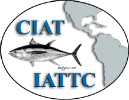One of the main components of the CAPAM workshop series is a set of focus questions. These questions are developed in advance of the workshop and are are used to promote discussion. They are also used to structure the workshop report. This topic in the Forum is a place where people can suggest candidate focus questions. It also allows people to discuss the focus questions setting up the discussions at the workshop and allows people who cannot attend the workshop participate. Anyone can view the discussion, but to post a comment you will need to send a request to jvalero@iattc.org to register to the Forum.
You are here
CAPAM Updates:
Tuna Stock Assessment Good Practices Recordings Available NEW
Natural Mortality Workshop Report Available NEW
Tuna Stock Assessment Good Practices Workshop NEW
Praise for CAPAM and its Workshops NEW
Model Weighting Workshop Presentations and Recordings Available NEW
Model Weighting Workshop Completed
Model Weighting Workshop Announcement
COVID protocol and Passport requirement for Good Practices Workshop
Stock Assessment Good Practices Workshop Agenda
Stock Assessment Good Practices Workshop Announcement
Diagnostics Workshop Completed
Diagnostics Workshop Focus Questions
Integrated Stock Assessment Model Diagnostics Workshop Announcement
Next Generation Stock Assessment Models Workshop Report
A no BS guide to fishery stock assessment
Natural Mortality Workshop completed
Special Issue on Natural Mortality
Natural Mortality Workshop new dates
Presentations from Next Generation Stock Assessment Models Workshop
Abstracts for Next Generation Stock Assessment Models Workshop
Agenda for Next Generation Stock Assessment Models Workshop
General stock assessment model features survey
Focus Questions for Next Generation Stock Assessment Models Workshop
Natural Mortality Workshop 2nd Announcement
Next Generation Stock Assessment Models Workshop 2nd Announcement
Natural Mortality Workshop 1st Announcement
Five CAPAM Special Issue papers among 25 most cited from Fisheries Research
Spatial Assessments Workshop Presentations
Spatial Assessments Workshop Focus Questions
Spatial Assessment Models Workshop Abstracts
Spatial Assessment Models Workshop Agenda
CAPAM awarded William E. Ricker Resource Conservation Award
Spatial Assessment Models Workshop 2nd Announcement
CAPAM Associated Scientist Story for SAFS Centennial
Special Issue on Spatio-Temporal Modeling
CAPAM Workshop Series Report 3
Spatio-temporal modelling Mini-Workshop Talks
Spatio-temporal modelling Mini-Workshop Agenda
CAPAM awarded AIFRB Outstanding Group Achievement Award
Spatio-temporal modeling Mini-Workshop 2nd Announcement
Stock Assessment Course, Italy
Recruitment Workshop Draft Agenda
Provocative view on the stock-recruitment relationship for discussion at the Recruitment Workshop
Recruitment Workshop 3rd Announcement
Stock assessment position open at IATTC
Published Special Issue on Data Weighting
Upcoming Spatio-Temporal Modelling Mini-Workshop
Harvest Strategies Course, Argentina
White Seabass Stock Assessment
CAPAM PI appointed to the Scientific Advisory Committee of ISSF
National Oceanographic and Atmospheric Administration

Scripps Institution of Oceanography

Inter-American Tropical Tuna Commission


Here is a current list of focus questions for use at the growth workshop. Some answers to these questions can be found at http://www.fisheriesstockassessment.com/TikiWiki/tiki-index.php?page=Gro.... Please discuss these questions here and propose any additional questions.
What should be done if the asymptotic length (linf) is uncertain and the model is fit to length composition data?
Is the von Bertallanfy growth equation adequate or should other growth equations be considered?
Should non-parametric methods be used for modelling growth?
Is there a growth form that performs well in most applications?
When there are no sex-specific biological data, but growth is thought to differ among sexes, should a sex-structured model be used?
What methods can be used to diagnose growth misspecification and assist appropriate specification?
How important are growth uncertainties compared to other typical assessment uncertainties, such as the form of the stock-recruitment relationship, catchability estimation, choice of a FMSY proxy, etc.?
How do growth model assumptions interact with key management parameters?
Should forecasts include trends in growth?
Is it inappropriate to rely on simplifying assumptions when modeling selectivity?
Is the influence of selectivity on growth estimates something to be concerned about?
How should growth curves be fit to data to avoid the abundant data points at intermediate aged fish influencing the mean size at age for old fish?
Can underlying processes be used to determine a growth form (e.g., linear, von Bertalanffy)?
What is the best model for variation of length at age?
How should variation in length at age other than individual growth variation be dealt with?
How should age-length data be combined with tagging growth increment data to provide improved estimates of growth?
How should aging error be incorporated in the stock assessment model?
Should age length data be used inside the stock assessment model to estimate growth?
Is the assumption that length at age normally distributed adequate?
When is it better to using empirical weight at age and catch-at-age versus modeling time varying growth and using length composition data and age-conditioned on length data?
How does the choice of the plus group interact with growth specification and estimation?
When estimating growth inside a stock assessment model does one fishery need to have an asymptotic selectivity to stabilize estimation?
What is the asymptotic length confounded with: a) the specification of natural mortality (M); b) increased age-specific M for older fish; c) the selectivity of the oldest age class?
Are VPAs using cohort slicing more or less sensitive to growth assumptions than integrated stock assessment models that fit to length composition data?
When and how should temporal variation in growth be modeled?
How should spatial variation in growth rates be dealt with in spatial models?
Time-invariant (constant) growth is a strong assertion. Is it justified and how does it influence model results?
What is the evidence for the two stanza growth proposed for tuna?
I have answered most of the focus questions (except a few in the Theory and experimental evidence section), so it would be a good time to have a look at them and provide some feedback.
(note disable rich-text to paste from word when posting to the forum)
The focus questions and answers can be found at
http://www.fisheriesstockassessment.com/TikiWiki/tiki-index.php?page=Gro...
Here are a couple of alternative growth models. Any comments would be appreciated. Age based increment model with time varying K and resulting time varying Linf An alternative growth increment where the increment is a function of age rather then length was proposed as a method that allows the maximum length to change over time. Modeling the K parameter as a function of time might be more appropriate in this model than when the growth increment is a function of length for which the maximum length does not change over time or if it does allows fish that reach their final growth to start growing again. L(a)=L(a-1)+[amax-a][1-exp[-K(t)]] Hybrid linear growth for juveniles and von Bertalanffy growth for adults Growth for many species (e.g. tuna) appears to be linear for juveniles, but slow down rapidly when they mature. Below is a growth curve that attempt to implement this type of model. L(t)=[1-p(t)][a+bt]+p(t)[a+bc+VB(t)] VB(t)=[L_∞-[a+bc]][1-exp[-K[t-t_0 ]]] p(t)=[1+exp[-ln[19][t-t_50 ]/[t_95-t_50 ]]]^(-1) t95 could be fixed at t50 + 0.1 to make an abrupt change c could be set equal to t50 t0 could be set to t50 t50 could be set at the approximate age at maturity The von Bertalanffy could be replaced with a Richards growth curve
Recently there was a ICES symposium on otoliths that might have some information relevant to the CAPAM growth workshop
http://ices.dk/news-and-events/Documents/Symposia/Otolith/ISO2014%20Book...